The manuscript currently preserved in our library under the shelfmark Isl. Ms. 350 has a fascinating history that can be traced in internal owners’ marks and external documentary sources. The compact volume carries a richly illuminated copy of a selection of Persian poetry gathered under the title Ganj al-maʻānī, or Treasure trove of Sublimities.
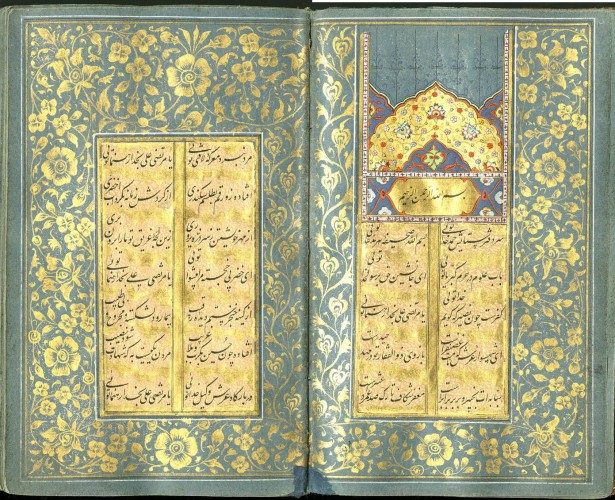
Illuminated opening of Isl. Ms. 350
Passing through the hands of a series of owners, primarily by gift or bequest, the manuscript made its way from Delhi to London and from London to Istanbul before eventually reaching Ann Arbor by means of Italian and Egyptian book dealers. In this first of two posts, we'll explore how the manuscript reached Istanbul.
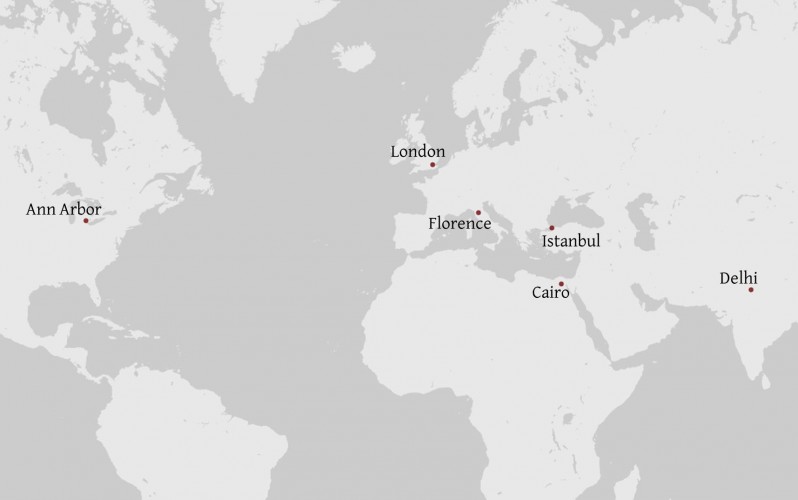
Significant stops on the manuscript's journey
The manuscript's story begins in Delhi, formerly known as Shāhjahānābād, where according to its colophon (p.346-7), it was transcribed (and possibly compiled) by a certain Riz̤ā who completed the copy on Tuesday, 24th of Dhū al-Ḥijjah 1156 [ca. 8 February 1744] on the order of one Nawāb Shīr Jang Bahādur.
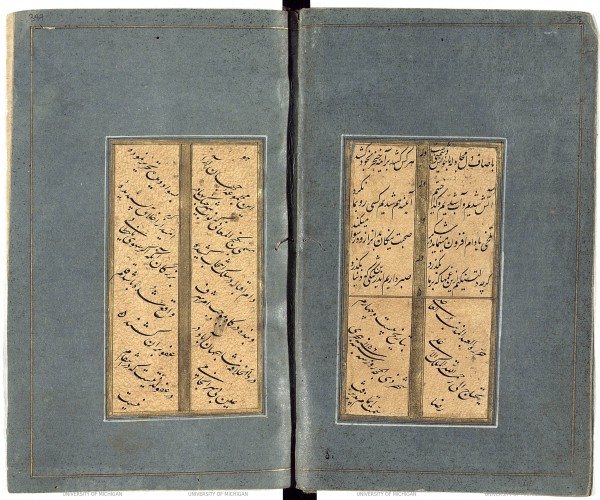
View of the colophon in Isl. Ms. 350
This Shīr Jang is most likely Nis̲ār Muḥammad Khān, nephew of the first Nawab of Oudh (i.e. Awadh), Saʻādat Khān (r. 1722-1739), and cousin of his successor Ṣafdar Jang (Mirzā Muḥammad Muqīm, r. 1739-1754). Shīr Jang served both his uncle and nephew in battle as a skilled general. He also served as Ṣafdar Jang’s deputy in Kashmir. [1] Apparently he was also a bibliophile who commissioned and collected several magnificent manuscripts, Isl. Ms. 350 among them.
Another manuscript of Persian poetry produced on his order has been recorded among the Persian manuscript holdings of the Khuda Baksh Library in Patna. [2] Further, at least ten manuscripts now residing in the Bibliothèque nationale de France (BnF) were either commissioned by Shīr Jang or presumably collected by him. [3]
Francis Richard has noted several of these manuscripts among those acquired by the French collector Jean-Baptiste Gentil (1726-1799), including the famous album of calligraphic specimens and paintings now preserved in the BnF under the shelfmark Smith-Lesouëf 247. [4] According to a note entered in this album by Gentil or his secretary, the 60 pieces were collected and bound together for a certain Shīr Jang, identified as governor of Kashmir under the Mughal emperor Muḥammad Shāh (r. 1719-1748) and as of 1768 retired at Faizabad near Patna in the region of Awadh. The dates and context certainly suggest the Shīr Jang who commissioned Isl. Ms. 350. [5]
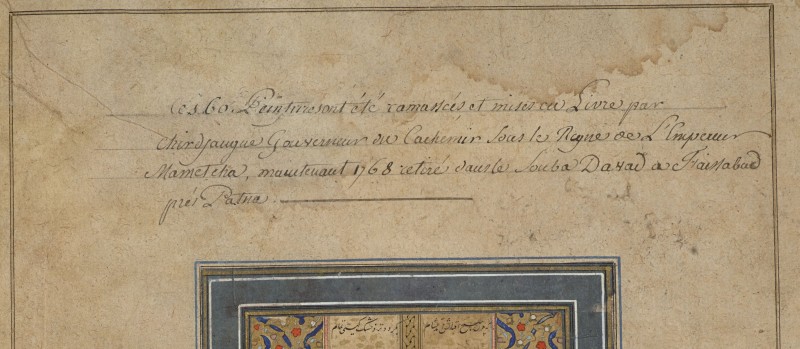
View of note in BnF Smith-Lesouëf 247, f.35v, available for
online viewing and download via Gallica.
Most of the other BnF manuscripts in question can be associated with Shīr Jang by way of dated seal impressions in the name of Muʻizz al-Dawlah Shīr Jang Bahādur. Dates in the seal impressions range from 1162 [1748 or 9] -- just a few years later than the date of Isl. Ms. 350 -- to 1172 [1758 or 9], still earlier than the 1768 date of Shīr Jang’s retirement provided by Gentil. [6] Many of these seal impressions are accompanied by inspection notices dated Rabīʻ I 1177 [September 1763] in the name of one Muḥammad Shahriyār. [7]
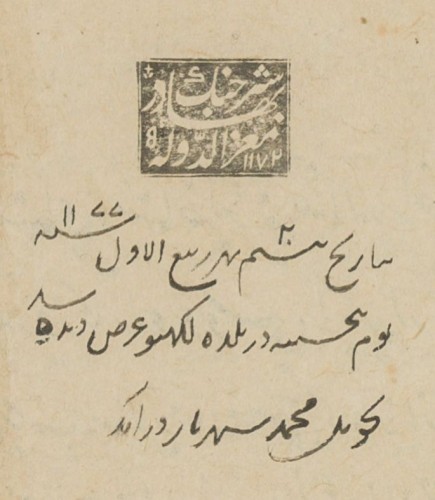
Seal impression in name of Muʻizz al-Dawlah Shīr Jang Bahādur dated 1172 [1758 or 9] accompanied by inventory note
(BnF Suppl. pers. 288, f.1r, available for
online viewing and download via Gallica)
Once again, the compatible dating and context allow us to associate the seal impression (which further supplies the honorific Muʻizz al-Dawlah) with the Shīr Jang of Isl. Ms. 350.
From the library of its patron Shīr Jang, the manuscript eventually made its way to London in the hands of James Caulfeild (1783-1852), a soldier and political officer in British India who later served as Director of the East India Company (1848-1851) and briefly as a Member of Parliament (MP) for Abingdon (July-November 1852). [8] His bookplate appears on the final flyleaf of the volume.
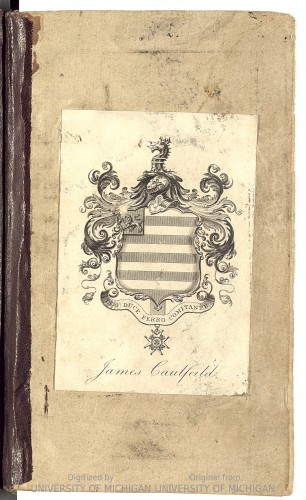
Bookplate of James Caulfeild on final flyleaf of Isl. Ms. 350
It is unclear how and when Caulfeild acquired the manuscript, though it was likely sometime during his service in India between 1799 and 1841. Gentil's acquisitions suggest that Shīr Jang's library was being dispersed (at least in part) from the second half of the 18th century, [9] and Caulfeild may have been able to purchase the manuscript just as Gentil had done with other holdings from the collection of Shīr Jang. What is clear is that Caulfeild eventually gifted the volume to another. An inscription on the opening flyleaf indicates that on 2nd October 1851, while serving as Director of the East India Company in London and just before his promotion to Lt. Gen. in November 1851, [10] he presented the volume to one “Prince Ickbaloodaulah.”

Gift inscription by Caulfeild in Isl. Ms. 350 (front flyleaf)
This “Prince Ickbaloodaulah” is very likely Iqbāl al-Dawlah Burhān al-Mulk Muḥsin ʻAlī Khān Bahādur (b.1808), author of the Icbal-e-furung (Iqbāl-i Farang) and claimant to the throne of Oude. [11]
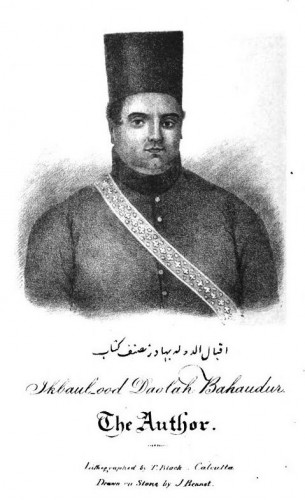
Portrait of Iqbāl al-Dawlah reproduced in his
Icbal-e-furung [= Iqbāl-i Farang], Calcutta: Medical Press, 1834.
He was apparently present in London from the year 1838 in order to make his case as claimant. [12] It is certainly plausible that he stayed on and eventually encountered Maj.Genl. Caulfeild in 1851, likely in the context of the latter’s role as Director of the East India Company.
The manuscript apparently did not remain with Iqbāl al-Dawlah for long, however. Yet another inscription on the opening flyleaf indicates that he himself later gifted the volume to “H.E. ʻAlee Pasha.”
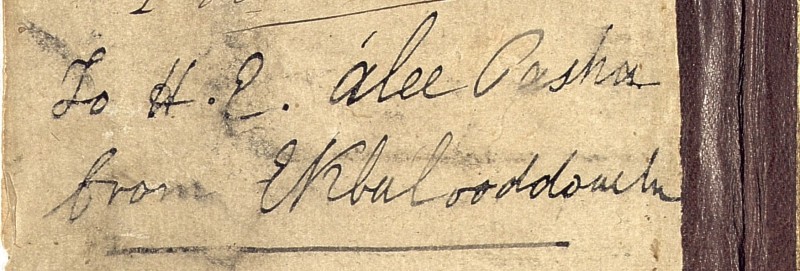
Gift inscription by Iqbāl al-Dawlah in Isl. Ms. 350 (front flyleaf)
This “ʻAlee Pasha” is presumably Mehmet Emin Âli Paşa (1815-1871), an important Ottoman statesman of the Tanzimat era who was also a highly respected diplomat in European circles. Like Iqbāl al-Dawlah, he also made his way to London in 1838, in the company of the Ottoman ambassador. He returned in 1841 as ambassador himself, a post which he held until 1844. He served in various positions thereafter, including Minister of Foreign Affairs and Grand Vizier on multiple occasions. It may have been during any of his numerous stints as foreign minister after October 1851 that he had occasion to encounter Iqbāl al-Dawlah and receive from him the manuscript. [13]
Âli Paşa almost certainly brought the manuscript back to Istanbul where he may have later gifted or bequeathed it to his son Mustafa Reşit. At least seven other manuscripts now in our holdings apparently once belonged to Mustafa Reşit, bearing a statement and/or seal impression in his name. [14]
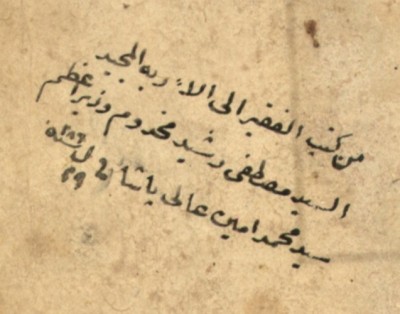
Ownership statement dated 29 Shawwāl 1286 [February 1870], in name of Mustafa Reşit, son of the Grand Vezir
Mehmet Emin Âli Paşa, in Isl. Ms. 308 (p.1/f.1r)
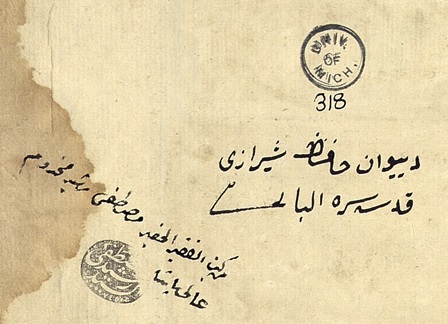
Ownership statement and seal impression for Mustafa Reşit
in Isl. Ms. 318 (p.1/f.1r)
With these and several hundred other manuscripts gathered in Istanbul, the volume eventually made its way to Ann Arbor.
More on that in the next post!
In the meantime, feel free to browse or download this manuscript in its entirety via the HathiTrust Digital Library.
You can also see it in person in our exhibit “Storied Acquisitions: Highlights from the University of Michigan Library Collections” (on display through 30th August) or in our reading room!
[1] See Barnett, North India Between Empires: Awadh, the Mughals, and the British, 1720-1801 (Berkeley, CA: University of California Press, 1980), p.34 esp. note 42 ; Srivastava, The first two Nawabs of Awadh (Agra: S.L. Agarwala, 1954), p.106 ; and p. 262 in Malik, “The Subah of Kashmir Under the Later Mughals 1708-1748,” In Medieval India: A Miscellany, Volume 2 (New York: Asia Publishing House, 1972): 249-262.
[2] “Splendid copy” of the lyrical poems of Fayz̤ī produced on the order of "Nawāb Shīr Jang Bahādur" with no date of transcription given. See no.109, p.70 in Khan Sahib Maulvi Abdul Muqtuadir, "A List of the more valuable Persian MSS. in the Library," In Scott O'Connor, An Eastern Library (Glasgow : Printed at the University Press by R. Maclehose, 1920): 54-72.
[3] Namely, Supplément persan 182, 193, 288, 505, 507, 576, 682, 810, 828 and Smith-Lesouëf 247. See the entries in Francis Richard, Catalogue des manuscrits persans, Bibliothèque nationale de France, Département des manuscrits, v.2 pt.1-2, Le supplément Persan 1 à 524 and Le supplément Persan 525 à 1000 (Roma: Istituto per l’Oriente C.A. Nallino, 2013). See also the entries for Suppl. pers. 182, 193, and 288 in the online catalogue for archives and manuscripts in particular.
[4] See p.97-98 in Francis Richard, “Jean-Baptiste Gentil, collectionneur de manuscrits persans.” Dix-huitième siècle 28 (1996): 91-110 ; Others include Supplément persan 288, 505, 507, 576, 682, 810, 828 cf. Richard 1996 p.95, 98 and Richard 2013 p.1139.
[5] In his Mémoires, Gentil further mentions Shīr Jang as a source for his discussion of the military exploits of Muḥammad Shāh (r.1719-1748). He refers to Shīr Jang as a nawab and identifies him as a cousin of the nawab Shujāʻ al-Dawlah whose court Gentil attended in Awadh. See p.6 and p.128 note 1 in Jean Baptiste Joseph Gentil, Mémoires sur l'Indoustan, ou Empire Mogol, Paris: Petit, 1822.
[6] Again see the catalogue of Richard and online entries. Yet another date 1176 [1762 or 3] is reported for Suppl. pers. 507, but the reading 1172 seems more likely (see the image reproduced in fig. 103, Richard 2013 p.678).
[7] See, for example, Suppl. pers. 193, 288, 507. For a discussion of such inspection notices, see John Seyller, "The Inspection and Valuation of Manuscripts in the Imperial Mughal Library," Artibus Asiae 57, 3/4 (1997): 243-349.
[8] See V. C. P. Hodson, List of the Officers of the Bengal Army, 1758-1834. Alphabetically arranged and Annotated with Biographical and Genealogical Notices (London: Constable, 1927), p.321
[9] Gentil apparently purchased Suppl. pers. 810 as early as 1765, see Richard 1996 p.95
[10] Again see Hodson p.321 and p.328 in C.H. & D. Philips, “Alphabetical List of Directors of the East India Company from 1758 to 1858,” Journal of the Royal Asiatic Society of Great Britain and Ireland 4 (October 1941): 325-336.
[11] See The Title of the Family of Shams-ud-Dowlah to the Throne of Oude Considered (London: J. Harrison & Son, 1839), p.7 and Ikbāl al-Daulah Bahadur, Icbal-e-furung; or, British prosperity: being a short description of the manners, customs, arts, and science of the enlightened British. Accompanied by a literal translation into the English [= Iqbāl-i Farang] (Calcutta, Medical Press, 1834), p.4-5.
[12] See W. White, The Prince of Oude, or, The claim of the Nawaub Ekbal-ood-Dowlah Bahador to the throne of Oude (London : William Strange, 1838), p.5 and p.326 ff. in “The Prince of Oude Versus the East India Company,” Parbury’s Oriental Herald 2, X (1839):325-342.
[13] See Christoph Herzog and Harold Bowen, “Ali Paşa, Mehmed Emin,” In Encyclopaedia of Islam, THREE, Edited by Kate Fleet et al. Available online http://dx.doi.org/10.1163/1573-3912_ei3_COM_26327
[14] See the statements and seal impressions in Isl. Ms. 226, 308, 318, 371, 389, 399 and 409. Descriptions and digital images appear in the online catalogue.